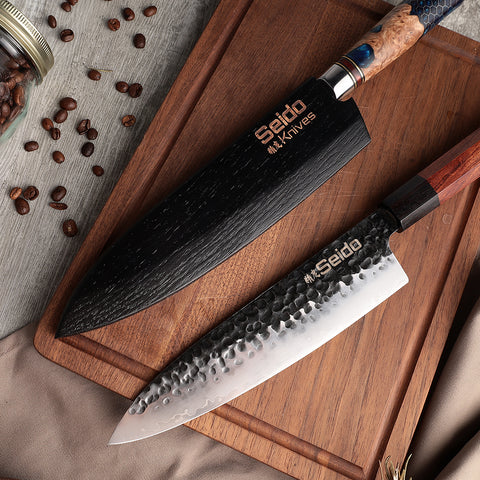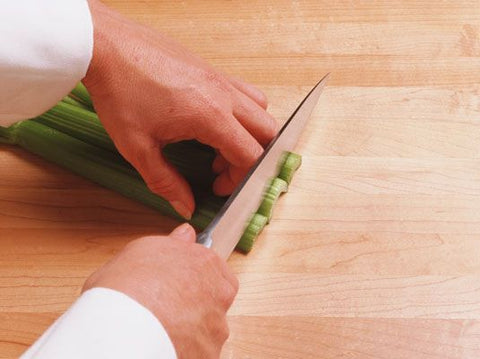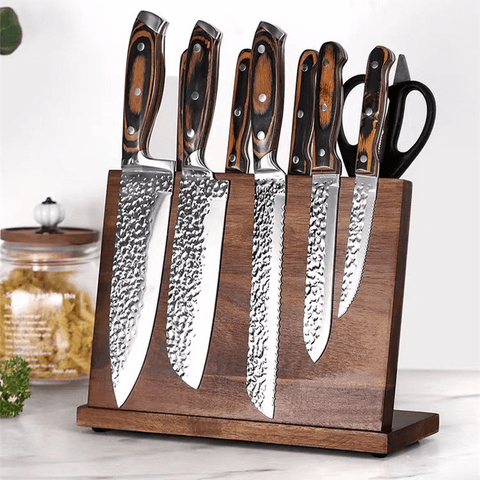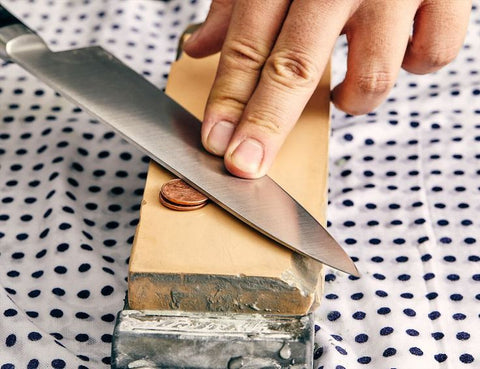Knives are necessary for many cooking and food preparation tasks in the kitchen, and knowing how to prevent cuts in the kitchen gives you the chance to do so safely. Using your knives properly and caring for them correctly can prevent many kitchen injuries while extending the life of your cutlery.
START WITH A SAFE KITCHEN TO AVOID MISHAPS
Before getting involved with knife safety in the kitchen, you must ensure a safe kitchen. Wear appropriate clothes with rolled-up sleeves and an apron so that your garments don't get in the way. Minimize extra cords throughout the kitchen to avoid spills, trips, and accidents. Don't handle your cutting near boiling liquids that might splatter or scare you, and clean up everything immediately to prevent slip-and-fall accidents. Wash your hands frequently with warm water and soap to prevent cross-contamination, and don't use the same cutting boards for raw meat and fruit or veggies. Supervise children and pets in the kitchen area, or keep them out.
Practice Knife Safety with Our Saya Knife Sheath
MOST COMMON KITCHEN ACCIDENTS WITH KNIVES
Your specific knife safety tips will vary based on your specific task. If you haven't learned them already, find out the 6 Classic Knife Skills You Need in the Kitchen.

Shop Our Knife Sheath to Secure your Knife's Edge →
DICING ROUND VEGGIES AND FRUITS
Knife handling and safety are crucial with foods that are hard to grip and might roll around. Cut them in half to make them easier to manage on flat sides.
CUTTING MEAT/DEBONING
Knife safety also matters with meat. An electric knife makes cutting and deboning easier because you don't have to do the sawing manually. Use a paper or kitchen towel to hold slippery meat in place, and go slow with your boning knife.
CARVING
Kitchen knife safety continues with carving, which you should always do away from yourself and your holding hand. Keep your attention on the work, and do thin layers to prevent blade slips.
CHOPPING HERBS
Chopping herbs involves delicate leaves that can have your blade too close to your fingers. Use a claw grip to hold herbs with inward-tucked fingers to bunch them up.

CLEANING KNIVES
Don't drop dirty knives in your sink where they can rust or hurt someone reaching in there later. Wash and dry them immediately before storing them. A Magnetic Bamboo Multi-Function Knife Holder can help.
IMPROPER KNIFE STORAGE
Knives stored in drawers can ding and hurt people looking for other utensils. Brush up on Knife Storage 101: Learn the Best Knife Storage Solutions.

Safely Secure your knife with our Magnetic Block →
BASIC KITCHEN SAFETY TIPS
Safely using kitchen knives means precautions before, during, and after use. The following are several things you should know.
KEEP YOUR KNIVES SHARP
Sharp knives are more precise and require less force, which adds to safer use. Make sure your kitchen has Rosewood Diamond Honing Steel to keep blades sharp or go all out with the Professional Whetstone Set, Knife Sharpening Stone Kit

UTILIZE CUTTING BOARDS
The best cutting boards don't slide. A stable surface for cutting makes the task easier, quicker, and safer.
STAY ORGANIZED
Organization prevents accidents in nearly any activity, and kitchens are no exception. Never trip over a pot or get surprised by something splashing to the floor.
ATTENTIVE COOKING
Cooking should never go unattended, especially if you have a burner on, boiling water, or hot oil. Any distraction can result in a burn or fire. Always be attentive when you're cooking.
FIRE EXTINGUISHER
A fire extinguisher doesn't keep you safe from knife cuts, but your kitchen needs it if you bump into something and a kitchen towel flares up. Keep a unit where you can reach it to douse flames fast.
BEST WAYS TO PREVENT CUTS IN THE KITCHEN
Knowing how to prevent kitchen cuts is a subtle skill that takes ordinary cooks to a new level.
HANDLE KNIFE BLADES WITH CARE
Grip the knife with your cutting hand. Use your helping hand to hold, stabilize, and move whatever you cut. Always position every finger so that it's physically impossible to cut them.
STORE YOUR KNIVES SAFELY
If you have to store knives in a drawer, put them in protective sheaths. If you have young ones around, use a childproof lock.
NEVER CUT TOWARD YOURSELF
Your knife edge should always move and face away from your body. Hold it facing away from you even when just holding it.
LEARN BASIC KNIFE SKILLS
Home cooks don't need the high-level skills aspiring chefs seek to master, but you need to know how to slice, dice, cut, chop, and peel.
MAKE SURE TO USE THE APPROPRIATE KNIFE FOR EACH JOB
Using a wrong-sized knife causes problems. Any blade too large or small uses too much force or over-cuts. They can also slip.
FAQs
Q: Aren't chef's knives inherently more dangerous than regular kitchen knives?
A: Any knife can result in injury if it's not handled properly.
Q: How do food service professionals stay safe?
A: Restaurant employees honor their training, use safe techniques, and are constantly mindful of their work.
EMBRACE YOUR COOKING EXPERIENCE WITH A LEARNING ATTITUDE!
Becoming a better cook involves learning new recipes and cooking skills, and learning how to safely use knives means you get more time and confidence in your kitchen.
Securely store your knives with Seido's Storage accessories →



